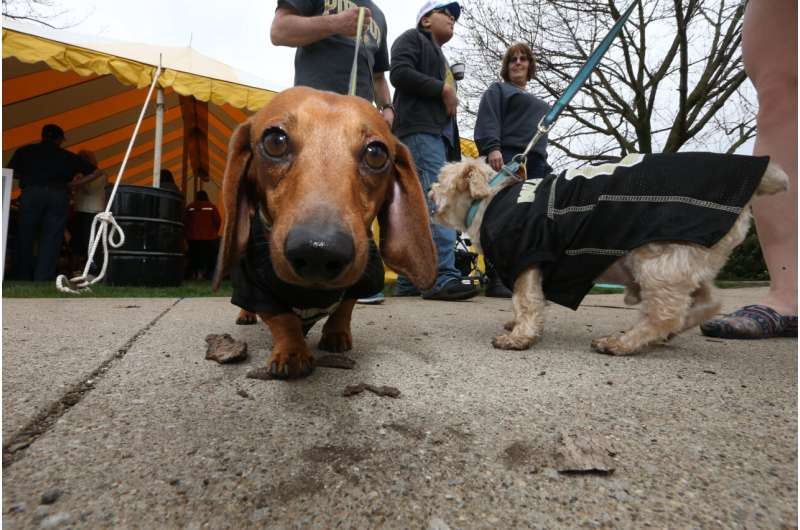This article has been reviewed according to Science X's editorial process and policies. Editors have highlighted the following attributes while ensuring the content's credibility:
fact-checked
trusted source
proofread
Lack of canine COVID-19 data fuels persisting concerns over dog-human interactions

Early COVID-19 pandemic suspicions about dogs' resistance to the disease have given way to a long-haul clinical data gap as new variants of the virus have emerged.
"It is not confirmed that the virus can be transmitted from one dog to another dog or from dogs to humans," said veterinarian Mohamed Kamel, a postdoctoral fellow at Purdue University.
During the pandemic's early days, dogs seemed resistant to the coronavirus, showing little evidence of infection or transmission, said Mohit Verma, assistant professor of agricultural and biological engineering and Purdue's Weldon School of Biomedical Engineering. "As the virus evolved, or maybe the surveillance technology advanced, there seem to be more instances of potentially asymptomatic dogs," Verma noted.
These are among the findings that Kamel, Verma and two co-authors summarized in a research literature review titled "Interactions Between Humans and Dogs in the COVID-19 Pandemic." The summary, with recent updates and future perspectives, recently appeared in a special issue of the journal Animals on Susceptibility of Animals to SARS-CoV-2.
Additional co-authors are Rachel Munds, a research scientist at Krishi Inc. and a Purdue visiting scholar in the Department of Agricultural and Biological Engineering, and Amr El-Sayed of Egypt's Cairo University.
Last June the U.S. Department of Agriculture's Animal and Plant Health Inspection Service announced it was committing up to $24 million for research related to SARS-CoV-2. The funding, provided by the American Rescue Plan Act, focuses on the One Health concept, which recognizes the link between the health of people, animals and the environment.
The SARS-CoV-2 virus that originated in Wuhan, China, in 2019 has infected more than 600 million people globally and had claimed more than 6.5 million lives by October 2022.
"COVID-19 has become one of the most important economic, health and humanitarian problems of the 21st century," the co-authors wrote in the Animals article. Studies have documented the movement of the SARS-CoV-2 virus through various animal species, and about 75 percent of infectious diseases in humans start in animals.
"This spread raises concerns about the possibility of pet animals serving as reservoirs for the virus," the co-authors wrote.
More than two dozen animal species have been infected by SARS-CoV-2 virus, ranging from cats, dogs and rabbits to deer, cattle and gorillas. More than 470 million dogs were owned worldwide before the COVID-19 outbreak. Their susceptibility to the virus remains poorly understood because they are infrequently tested, said Kamel, who is also a faculty member at Cairo University.
"Compared to cats or other animals, the susceptibility is less," Kamel said. He cautioned, however, that the susceptibility of dogs to the new variants may have changed to a lesser or greater extent.

"There are a lot of variants. It's not only one virus," Kamel said. "The infections differ from the old variant to the new variant."
Dogs' apparent resistance to COVID-19 could result from their general low levels of the angiotensin converting enzyme (ACE2), target receptors in their lung cells and related mutations.
"ACE2 is the main part of the virus attachment found on the cells," Kamel noted.
The Animals journal article also discusses how the spread of an epidemic can be tracked, predicted and contained through a combination of geographic information systems, molecular biology and even detection dogs. Because of their heightened sense of smell, dogs can be trained to detect a wide range of human diseases, Kamel said. Using dogs to detect COVID-19, as reported in the journal article, is fast and less expensive compared to other methods where screening large crowds may be needed.
Verma's startup, Krishi Inc., is already developing innovative paper-based, rapid-result tests for bovine respiratory disease, antimicrobial resistance and COVID-19. The testing system uses a method called loop-mediated isothermal amplification (LAMP) and is under development in Verma's lab for produce safety applications. Adapting LAMP for animal testing of SARS-CoV-2 may come next.
The Animals journal article cites multiple studies from Purdue and elsewhere validating the usefulness of LAMP testing. Krishi's focus thus far has been developing a test for antimicrobial resistance in animals, but the LAMP assay has broader potential, Verma said.
"If we want to do widespread surveillance, can we make our test versatile for any species? LAMP is portable," Verma said. "Because it can be done in a simple manner and provide results without a lab setup, we can potentially do this on a wider scale and make it cost-effective."
Currently available commercial at-home coronavirus tests for humans can also be used on dogs and cats. However, these tests may not be sensitive enough to detect the lower viral loads in animals.
"They're not validated for animals, so we don't know how well they would work. That's the gap we're hoping to bridge with the test that we are developing—better tools of surveillance," Verma said.
More information: Mohamed S. Kamel et al, Interactions between Humans and Dogs during the COVID-19 Pandemic: Recent Updates and Future Perspectives, Animals (2023). DOI: 10.3390/ani13030524
Provided by Purdue University



















